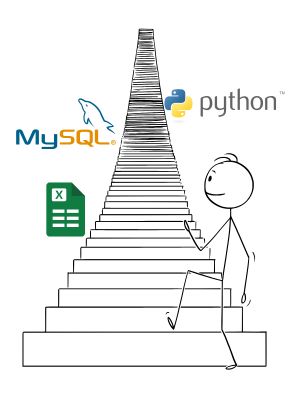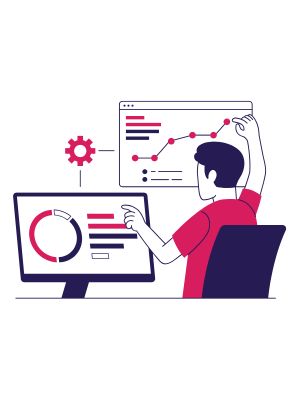The career path of a data scientist usually begins in entry-level roles like Data Analyst or Junior Data Scientist, progresses to mid-level positions such as Data Scientist or Machine Learning Engineer, and advances to senior roles like Lead or Principal Data Scientist. From there, professionals can branch into management roles like Data Science Manager or CDO, or specialize as Research Scientists and Distinguished Engineers.
In this guide, we’ll walk through each stage in detail—covering the skills, responsibilities, and choices that shape a successful data science career, plus tips to help you grow faster at every step.
Starting Out — Entry-Level Roles in Data Science
Everyone starts somewhere, and in data science, that “somewhere” usually means helping more experienced teammates turn raw data into something useful. For most, the first stop is as a Junior Data Scientist, Data Analyst, or Junior Machine Learning Engineer. The titles sound different, but the early work is similar—cleaning datasets, building small reports, and learning how the bigger pieces fit together.

In these roles, you’re not expected to design complex algorithms from scratch. You’re there to build strong foundations: clean messy spreadsheets, run queries, create simple visualizations, and support senior data scientists with their projects. Some days you’ll be tweaking a dashboard in Power BI or Tableau. Other days, you might be writing a Python script to fix a small data issue. It’s hands-on work that helps you learn faster than any course can teach you.
How to Land an Entry-Level Job
To land one of these roles, you’ll need to show you’ve done more than just read about data science—you’ve actually practiced it. That means being comfortable with Python, SQL, or R for cleaning and analyzing data, having a grasp of basic statistics and linear algebra, and knowing your way around visualization tools like matplotlib, Tableau, or Power BI. Even understanding Git for version control and using Python libraries like pandas and NumPy can set you apart. You don’t need to master everything before you apply, but these are the non-negotiables that make you productive from day one.
Getting your foot in the door isn’t just about skills—it’s about proof. Build small projects and post them to GitHub so hiring managers can see your code. Take on internships, bootcamps, or certifications to show you’ve put in the work. And don’t underestimate the power of networking—many entry-level jobs are filled before they’re ever posted. A connection on LinkedIn or a recommendation from someone in the field can open doors faster than sending out dozens of applications.
The early days in data science are about learning, contributing, and building credibility. You may not be creating the next big AI model, but you’ll be learning the habits, tools, and problem-solving skills that will carry you through every stage of your career.
Mid-Level — Gaining Specialization and Ownership
By the time you hit mid-level, the training wheels are off. You’re the person others trust to take a messy problem and ship something real. Your title might say Data Scientist, ML Engineer, Applied Scientist, or even Research Scientist in a tech-heavy team—but the theme is the same: you own outcomes.

Your day shifts from “helping with tasks” to “leading the project.” You design pipelines end to end, choose the right features, and push models to production. You sit with product and engineering, ask sharp questions, and turn ideas into measurable wins. A junior asks how to structure a dataset; you sketch the plan, review their code, and explain why it works.
This is also where your toolkit deepens. Python is now paired with Docker and a small web layer (Flask or FastAPI) so models can serve traffic. You’re comfortable in the cloud—AWS, GCP, or Azure—and you know the gotchas of cost, scaling, and logging. You can reach for XGBoost when it’s a tabular slam dunk, or pick a neural net when the problem calls for it. Most importantly, you tie every choice back to impact: revenue, retention, latency, or risk.
How do you grow faster here? Ship visible wins and write about them—short posts, internal talks, or a tidy Kaggle write-up. Mentor one person well. Volunteer for a project with exec eyes on it. If your path feels stuck, a smart internal transfer can expose you to bigger problems and better teammates.
Mid-level is where you build your reputation: reliable, thoughtful, and effective. Nail this stage, and the senior roles—strategy, platforms, hiring—start calling.
Senior-Level — Strategy, Impact, and Leadership
By the time you reach senior level, the game changes. You’re no longer just solving problems—you’re deciding which problems matter. Your title might be Senior Data Scientist, Lead Data Scientist, or Principal Data Scientist, but what defines you now is ownership, influence, and the ability to connect data work directly to business impact.

You lead projects end to end—scoping requirements, setting timelines, guiding technical decisions, and ensuring delivery meets real needs. You work directly with executives and cross-functional leaders, turning business goals into measurable data strategies. When priorities shift, you adapt fast and keep the team moving in the right direction.
Technical skills still matter, but they’re applied differently. Instead of just coding a model, you might design the framework others use to deploy models at scale. You might restructure a data pipeline so it supports five future products instead of one. Every decision is about scale, maintainability, and long-term value.
Mentorship and team building also take center stage. You’re helping others grow, setting standards, and shaping the team’s culture. You influence hiring, onboarding, and how knowledge gets shared.
To grow beyond this stage, you need visibility. Deliver projects that change how the company works or makes decisions, and make sure the right people know about them. Show that you can not only deliver, but also anticipate future challenges and opportunities.
This is the stage where you become more than a technical contributor—you’re a strategist. From here, the path branches: lead teams as an executive or go deeper as a technical expert. Both require the same foundation—trust, impact, and vision.
Executive and Specialized Career Tracks
Reaching the top of the data science ladder doesn’t mean there’s only one direction to go. At this stage, your expertise and influence open two main paths—leading teams or pushing technical boundaries. Which one you choose depends on where you find the most satisfaction: guiding people or solving the hardest technical problems.
The managerial track puts you in roles like Data Science Manager, Director of Data Science, or Chief Data Officer. Here, you’re shaping the company’s data vision, allocating budgets, setting priorities, and ensuring the team delivers results that matter. You spend more time on hiring, mentoring, and strategic planning than hands-on coding. Your success is measured by your team’s impact, not your individual output.
The technical expert track keeps you close to the craft. Titles like Principal Data Scientist, Research Scientist, or Distinguished Engineer come with the freedom to innovate, experiment, and push the boundaries of what’s possible. You might design algorithms that become company standards, publish research, or lead initiatives that define the technical roadmap—without managing people directly.
Both paths require the same foundation: trust, proven impact, and the ability to align technical work with business outcomes. The difference is in focus—one grows people, the other grows technology. Many senior professionals even blend the two, taking leadership roles while staying involved in high-impact technical work.
At this point, you’re shaping not just your own career, but also the direction of your company’s data future. And from here, the journey can keep evolving as industries change and new opportunities emerge.
Alternate Paths and Adjacent Roles
Not every data science career follows the traditional ladder. Some professionals discover that their skills translate perfectly into related roles—ones that still leverage data expertise but offer new challenges and perspectives.
One common shift is into product-focused roles. As a Data Product Manager or Technical Product Owner, you’re no longer just building models—you’re shaping the data products themselves. You decide which features get built, how they integrate with other systems, and how they serve end-users. It’s a natural fit for data scientists who enjoy connecting technical capabilities to customer needs.
Others pivot toward academia or research, especially if they’re drawn to experimentation and theory over business delivery. This might mean pursuing a PhD, joining a think tank, or working in an innovation lab. These environments reward deep exploration and often give you the freedom to focus on cutting-edge methods without immediate commercial pressures.
Then there’s the startup or consulting route. As a Data Consultant, you solve high-impact problems for different clients, often working with lean timelines and varied tech stacks. As a Founding Data Scientist or even CTO, you’re setting up data systems from scratch—making every decision from architecture to deployment. It’s fast-paced, hands-on, and ideal for those who thrive on building from the ground up.
These alternative paths aren’t detours—they’re simply different ways to grow your career. And for many, they provide the variety, autonomy, or creative control that traditional corporate roles can’t match.
Tools and Soft Skills That Matter Across All Stages
No matter where you are in your career—entry-level, senior, or leading a team—some skills stay valuable from start to finish. Think of them as the constant gear in your toolkit.
Technical tools that never go out of style:
- SQL – query and shape data efficiently
- Python – automate workflows, build models, and integrate systems
- Jupyter notebooks – explore data, run experiments, and share insights
- Machine learning libraries – scikit-learn, TensorFlow, PyTorch
- Visualization tools – Seaborn, Plotly, Tableau, or Power BI
Even as new platforms emerge, these skills keep you productive and adaptable.
Soft skills are just as important. Communication helps you explain results to non-technical audiences. Curiosity keeps you learning as tools and methods evolve. Stakeholder alignment ensures you’re solving the right problems. And time management keeps you focused when urgent issues compete with long-term projects.
These aren’t tied to a single job title—they grow with you. Master them early, keep refining them, and they’ll remain assets no matter where your career goes.
How Long Does It Take to Climb the Ladder?
There’s no single timeline for becoming a senior or executive-level data scientist. Growth depends on your skills, opportunities, and the environment you’re in—but there are some general patterns most careers follow.
Typical timelines:
- Entry to Mid-Level: 1–3 years — once you’ve built strong core skills and delivered successful projects
- Mid to Senior: 3–6 years — gaining leadership experience, owning high-impact projects, and earning trust across teams
- Senior to Lead/Managerial: 6–10+ years — building a track record of strategic impact, mentoring others, and influencing company direction
Factors that can speed up or slow down progress:
- Company size – smaller companies may promote faster; larger ones often have more structured timelines
- Industry – tech tends to move quicker than traditional sectors like finance or healthcare
- Education – advanced degrees can help in research-heavy or specialized roles
- Proactiveness – learning continuously, taking initiative, and building a strong network can accelerate opportunities
Climbing the ladder isn’t just about putting in the years—it’s about consistently proving that you’re ready for more responsibility. Skills get you in the door, but impact and visibility move you forward.
Conclusion
The career path of a data scientist is as much about choices as it is about skills. While the steps from entry-level roles to leadership or specialized positions follow a general pattern, the real growth happens when you align your technical abilities with business impact. Each stage—whether it’s cleaning data in your first role or shaping company strategy at the top—builds on the habits, relationships, and problem-solving mindset you develop along the way.
The key is to treat your career as an evolving project. Keep refining your technical foundation, invest in communication and leadership skills, and stay open to adjacent opportunities that play to your strengths. The tools will change, industries will shift, but your ability to adapt and deliver value will keep you moving forward.
Your next step might be learning a new technology, mentoring a teammate, or taking on a project that scares you a little. Whatever it is, see it as part of a bigger journey—one where you’re not just following the career path of a data scientist, but actively shaping it to fit your goals.




